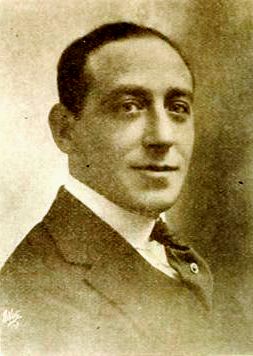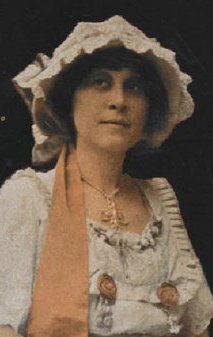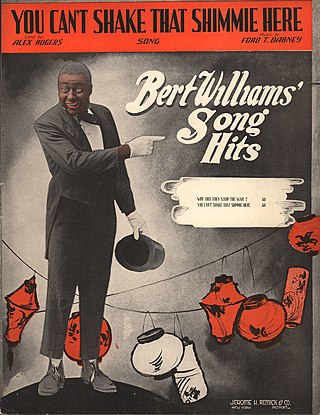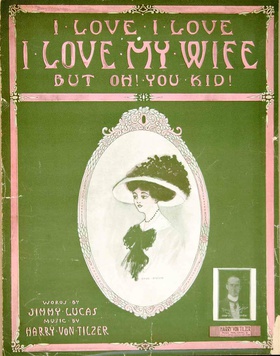
Arthur Francis Collins was an American baritone who was one of the pioneer recording artists, regarded in his day as "King of the Ragtime Singers".
Cecil Mack was an American composer, lyricist and music publisher.

On the Old Fall River Line is a song composed in 1913 by William Jerome (words), Andrew B. Sterling (words) and Harry Von Tilzer (music) set on a steamship of the Fall River Line of steamships between New York and Newport, Rhode Island, which connected with trains from Newport to Boston. Von Tilzer had often traveled the line and was inspired by honeymooners "stirred to romantic depths by the alliance of shadowy darkness, twinkling stars, softly lapping waves and stately moving ships." Popular during World War I, especially among New England soldiers, it was also "much parodied." It is a cheerful, up-tempo ditty, but, typically of its time, "there is a final twist to married bliss with the final chorus line of: 'But I wish "oh Lord" I fell overboard, On the old Fall River Line.'" Described by the New York Times as "a popular song of a quarter century ago" in 1937, its full chorus was used that same year in Time Magazine's article on the passing of the old steamboat line. Although still garnering a place in Billboard's 1949 listing of "Harry Von Tilzer's Best Known Songs" as late as 1949 and being described as "a famous verse" by The Christian Science Monitor in 1950, a dozen years after the last ship had sailed, it is less remembered today, although not completely forgotten. Modern-day performers have included Steve Martin and Tiny Tim.
W. Augustus Barratt was a Scottish-born, later American, songwriter and musician.
Roger A. Graham was an American lyricist, composer, singer, and music publisher who flourished from 1906 to 1920 — a period that included World War I, the golden age of Tin Pan Alley, the dawn of the Jazz Age (circa 1914), and the silent film era. Graham was a proponent of vaudeville and burlesque songs. But as a lyricist and publisher, Graham is most remembered for having been an exponent of blues songs.
Edward Frederick Teschemacher, was a prolific writer of song lyrics. He was born at Highbury, Middlesex, England and he was educated at Giggleswick School, Settle, North Yorkshire.

Felix F. Feist was a lyricist and Metro-Goldwyn-Mayer executive. He wrote the lyrics for songs in several Broadway shows. Leo Feist was his brother, Felix E. Feist was his son, and Raymond E. Feist is his grandson. Several of the songs he wrote the lyrics for became prominent. "Strolling 'Long the Pike" was a song set at the 1904 World's Fair in St. Louis. Ada Jones recorded the song "Bull Frog & Coon" in 1906 for Edison Records. It was also recorded by the Five Brown Brothers in 1911. Feist wrote the lyrics for the song now known as "Skidamarink", a popular children's song.

Mayme Gehrue was an American actress and dancer in musical theatre, vaudeville, and silent film.

Henriette Blanke-Belcher, also known as Henrietta Blanke-Belcher and later as Henriette B. Melson, was an American composer of popular music, especially waltzes and ragtime tunes.

Fleta Jan Brown Spencer was an American songwriter, composer, pianist, and singer.

Florence Kilbourne McPherran was an American pianist and composer of popular tunes, based in Chicago, Illinois.

Ford Thompson Dabney was an American ragtime pianist, composer, songwriter, and acclaimed director of bands and orchestras for Broadway musical theater, revues, vaudeville, and early recordings. Additionally, for two years in Washington, from 1910 to 1912, he was proprietor of a theater that featured vaudeville, musical revues, and silent film. Dabney is best known as composer and lyricist of the 1910 song "That's Why They Call Me Shine," which for eleven point four decades, through 2023, has endured as a jazz standard. As of 2020, in the jazz genre, "Shine" has been recorded 646 times Dabney and one of his chief collaborators, James Reese Europe (1880–1919), were transitional figures in the prehistory of jazz that evolved from ragtime and blues — and grew into stride, boogie-woogie, and other next levels in jazz. Their 1914 composition, "Castle Walk" – recorded February 10, 1914, by Europe's Society Orchestra with Dabney at the piano – is one of the earliest recordings of jazz.

George Wayne Fairman (1881–1962) was a lyricist, composer, and music publisher whose work includes popular songs. Several of his songs charted including two that reached #1. Fairman's work includes coon songs, ragtime, songs related to World War I, and a foxtrot.

Coon, Coon, Coon is a "coon song" from 1900. The words were written by Gene Jefferson and the music by Leo Friedman. The lyrics are about an African American concerned with his appearance including his skin color and hair type while not being accepted by a woman. He makes efforts to acquire Caucasian characteristics but fails and is called out. Songsheet cover for the music include caricatured African American faces and a photograph of minstrel performers of the song inset.

"Oh! You Kid!" was the title, or part of the title, of several popular songs published in 1908 and 1909. It became a widely used popular catchphrase. The most successful song using the phrase, "I Love, I Love, I Love My Wife – But Oh! You Kid!", was written by Harry Von Tilzer and lyricist Jimmy Lucas, and recorded by the duo of Ada Jones and Billy Murray.
Lola Carrier Worrell was an American composer who wrote instrumental music, songs, and at least one piece for musical theatre. Born in St. Johns, Michigan, she studied music with Carlos Sobimo, Francis Hendricks and Horace E Tureman. Lola married Edward S Worrell Jr. on January 12, 1891, and they had three daughters. The family maintained homes in New York and Colorado, where Lola founded the Denver American Music Society and served as its first president. She also organized and served as the pianist for the Chamber Music Quintet of Denver. Along with other musicians such as Caroline Holme Walker, Lola maintained a studio at Brinton Terrace in Denver, where she coached pianists, singers, and young composers. She gave recitals with contralto Louis Merten, whom she accompanied on piano. In addition to her work as a musician, Lola filed patents for dolls she developed in 1922, 1924, and 1925. The 1925 patent application described the doll as a "flapper doll." Her compositions included:
Sing and Be Happy is a series of animated sing-along films produced by Universal Pictures. The first film in the series was released in 1946.
Bert E. Peters was a composer in the United States. His work was published as sheet music.
Victor Herbert Smalley was a writer, reporter and promoter who worked at newspapers, songwriting, and playwriting in the United States. In 1907 he wrote "That Lovin' Rag" with music by Bernie Adler. He died at age 32 of appendicitis. Victor Records recorded The Peerless Quartet performing their song "That Fussy Rag" in 1910. Lou Busch recorded the song "Dat Lovin' Rag" he wrote with Adler on the 1950 album Honky-Tonk Piano, re-titled as "That Everlovin' Rag" and rearranged. It was also recorded by Dick Hyman in 1958 his a honky-tonk album as "Knuckles O'Toole". It and "That Fussy Rag" continue to be performed in the 21st century at various ragtime events.

"At the Devil's Ball", also spelled "At the Devils Ball", is a song composed by Irving Berlin. There are three published editions of the song's lyrics—the first was registered for copyright on November 14, 1912; the second and third editions were registered on December 17, 1912, and January 8, 1913, respectively. The song's lyrics are written in first person, and convey a dream about a visit to a formal dance party in Hell, hosted by the Devil.













